Real-Time Decision Making in First Mile and Last Mile Logistics: How Smart Scheduling Affects Energy Efficiency of Hyperconnected Supply Chain Solutions
Abstract
:1. Introduction
2. Literature Review
2.1. Conceptual Framework and Review Methodology
- formulate of research questions;
- select sources to the literature, like Scopus, Science Direct, Web of Science ResearchGate, or Google Scholar;
- reduce the number of articles by reading them and identify the main topic;
- define a methodology to analyze the chosen articles;
- describe the main scientific results;
- identify the scientific gaps and bottlenecks.
2.2. Descriptive Analysis
2.3. Content Analysis
3. Model of Real-Time Decision Making in Last Mile Logistics to Increase Energy Efficiency
- is the position of the delivery point k of the scheduled delivery route j of parcel delivery service provider (PDSP) i where , and ;
- is the hub’s position of PDSP i;
- is the position of the pickup point of the open task f, where ;
- is the position of the destination of the open task f.
4. Black Hole Algorithm-Based Optimization
- standard BHA;
- BHA with permanently decreasing Schwarzschild radius;
- BHA with Hawking radiation;
- BHA with Lucky stars;
- BHA with permanently decreasing Schwarzschild radius and Hawking radiation;
- BHA with permanently decreasing Schwarzschild radius and lucky stars;
- BHA with Lucky stars and Hawking radiation;
- BHA with permanently decreasing Schwarzschild radius, Hawking radiation, and lucky star.
5. Scenario Analysis of Real-Time Decision Making in Last Mile Logistics Focusing on Energy Efficiency
5.1. Scenario 1 with Non-Cooperating PDSPs, without Time Frame and Real-Time Scheduling
5.2. Scenario 2 with Cooperative PDSPs, without Time Frame and without Real-Time Scheduling
5.3. Scenario 3 with Cooperative Partners, without Time Frame, without Loading Capacity Limit, and with Real-Time Scheduling
5.4. Scenario 4 with Cooperative Partners, without Time Frame, with Limited Loading Capacity and Real-Time Scheduling
5.5. Scenario 5 with Cooperative Partners, Time Frame, Limited Loading Capacity, and Real-Time Scheduling
6. Conclusions
Funding
Conflicts of Interest
References
- Llorca, M.; Jamasb, T. Energy efficiency and rebound effect in European road freight transport. Transp. Res. Part A Policy Pract. 2017, 101, 98–110. [Google Scholar] [CrossRef]
- Marchi, B.; Zanoni, S. Supply Chain Management for Improved Energy Efficiency: Review and Opportunities. Energies 2017, 10, 1618. [Google Scholar] [CrossRef]
- Marchi, B.; Zanoni, S.; Ferretti, I.; Zavanella, L.E. Stimulating Investments in Energy Efficiency through Supply Chain Integration. Energies 2018, 11, 858. [Google Scholar] [CrossRef]
- Energy Efficiency as a Core Component of Industry 4.0—The Building Perspective. Available online: https://www.i-scoop.eu/industry-4-0/energy-efficiency-industry-4-0/ (accessed on 8 June 2018).
- Ranieri, L.; Digiesi, S.; Silvestri, B.; Roccotelli, M. A Review of Last Mile Logistics Innovations in an Externalities Cost Reduction Vision. Sustainability 2018, 10, 782. [Google Scholar] [CrossRef]
- Cronin, P.; Ryan, F.; Coughlan, M. Undertaking a literature review: A step-by-step approach. Brit. J. Nurs. 2008, 17, 38–43. [Google Scholar] [CrossRef] [PubMed]
- Ramanathan, R. Development of Indian passenger transport. Energy 1998, 23, 429–430. [Google Scholar] [CrossRef]
- Halldórsson, Á.; Kovács, G. The sustainable agenda and energy efficiency: Logistics solutions and supply chains in times of climate change. Int. J. Phys. Distrib. Logist. Manag. 2010, 40, 5–13. [Google Scholar] [CrossRef]
- Schøyen, H.; Bråthen, S. The Northern Sea Route versus the Suez Canal: cases from bulk shipping. J. Transp. Geogr. 2011, 19, 977–983. [Google Scholar] [CrossRef]
- Martinsson, J.; Lundqvist, L.J.; Sundström, A. Energy saving in Swedish households. The (relative) importance of environmental attitudes. Energy Policy 2011, 39, 5182–5191. [Google Scholar] [CrossRef]
- Coetze, L.; Eksteen, J. The internet of things—Promise for the future? An introduction. In Proceedings of the IST-Africa Conference, Gaborone, Botswana, 11–13 May 2011. [Google Scholar]
- Léonardi, J.; Baumgartner, M. CO2 efficiency in road freight transportation: Status quo, measures and potential. Transp. Res. Part D Transp. Environ. 2004, 9, 451–464. [Google Scholar] [CrossRef]
- Rehl, T.; Müller, J. Life cycle assessment of biogas digestate processing technologies. Resour. Conserv. Recy. 2011, 56, 92–104. [Google Scholar] [CrossRef]
- Miao, Z.; Grift, T.E.; Hansen, A.C.; Ting, K.C. Energy requirement for comminution of biomass in relation to particle physical properties. Ind. Crop. Prod. 2011, 33, 504–513. [Google Scholar] [CrossRef]
- Ferreira, J.G.; Andersen, J.H.; Borja, A.; Bricker, S.B.; Camp, J.; Cardoso da Silva, M.; Garcés, E.; Heiskanen, A.-S.; Humborg, C.; Ignatiades, L.; et al. Overview of eutrophication indicators to assess environmental status within the European Marine Strategy Framework Directive. Estuar. Coast. Shelf. Sci. 2011, 93, 117–131. [Google Scholar] [CrossRef]
- Dornburg, V.; Faaij, A.P.C. Efficiency and economy of wood-fired biomass energy systems in relation to scale regarding heat and power generation using combustion and gasification technologies. Biomass Bioenergy 2001, 21, 91–108. [Google Scholar] [CrossRef]
- Uslu, A.; Faaij, A.P.C.; Bergman, P.C.A. Pre-treatment technologies, and their effect on international bioenergy supply chain logistics. Techno-economic evaluation of torrefaction, fast pyrolysis and pelletisation. Energy 2008, 33, 1206–1223. [Google Scholar] [CrossRef]
- Lee, J.H.; Lim, S. The selection of compact city policy instruments and their effects on energy consumption and greenhouse gas emissions in the transportation sector: The case of South Korea. Sustain. Cities Soc. 2018, 37, 116–124. [Google Scholar] [CrossRef]
- Farahani, N.Z.; Noble, J.S.; Klein, C.M.; Enayati, M. A decision support tool for energy efficient synchromodal supply chains. J. Clean. Prod. 2018, 186, 682–702. [Google Scholar] [CrossRef]
- Stöhr, T.; Schadler, M.; Hafner, N. Benchmarking the energy efficiency of diverse automated storage and retrieval systems. FME Trans. 2018, 46, 330–335. [Google Scholar] [CrossRef]
- Sun, Q. Research on the influencing factors of reverse logistics carbon footprint under sustainable development. Environ. Sci. Pollut. Res. 2017, 24, 22790–22798. [Google Scholar] [CrossRef] [PubMed]
- Böttcher, C.; Müller, M. Insights on the impact of energy management systems on carbon and corporate performance. An empirical analysis with data from German automotive suppliers. J. Clean. Prod. 2016, 137, 1449–1457. [Google Scholar] [CrossRef]
- Hafner, N.; Lottersberger, F. Intralogistics systems - optimization of energy efficiency. FME Trans. 2016, 44, 256–262. [Google Scholar]
- Rao, P.H. Measuring Environmental Performance across a Green Supply Chain: A Managerial Overview of Environmental Indicators. Vikalpa 2014, 39, 57–74. [Google Scholar] [CrossRef] [Green Version]
- Müller, E.; Stock, T.; Schillig, R. A method to generate energy value-streams in production and logistics in respect of time- and energy-consumption. Prod. Eng. 2014, 8, 243–251. [Google Scholar] [CrossRef]
- Ferretti, I.; Zanoni, S.; Zavanella, L.; Diana, A. Greening the aluminium supply chain. Int. J. Prod. Econ. 2007, 108, 236–245. [Google Scholar] [CrossRef]
- Tamás, P. Innovative business model for realization of sustainable supply chain at the outsourcing examination of logistics services. Sustainability 2018, 10, 210. [Google Scholar]
- Fu, J.; Jenelius, E. Transport efficiency of off-peak urban goods deliveries: A Stockholm pilot study. Case Stud. Transp. Policy 2018, 6, 156–166. [Google Scholar] [CrossRef]
- Zaman, K.; Shamsuddin, S. Green logistics and national scale economic indicators: Evidence from a panel of selected European countries. J. Clean. Prod. 2017, 143, 51–63. [Google Scholar] [CrossRef]
- Zacharias, J.; Zhang, B. Local distribution and collection for environmental and social sustainability—Tricycles in central Beijing. J. Transp. Geogr. 2015, 49, 9–15. [Google Scholar] [CrossRef]
- Mancuso, P.; Costagli, G.; Casella, C. The “ELBA” project—Eco-friendly mobility services for people and goods in small Islands. WIT Trans. Ecol. Environ. 2013, 179, 1079–1090. [Google Scholar]
- Carballo-Penela, A.; Mateo-Mantecón, I.; Doménech, J.L.; Coto-Millán, P. From the motorways of the sea to the green corridors’ carbon footprint: The case of a port in Spain. J. Environ. Plan. Manag. 2012, 55, 765–782. [Google Scholar] [CrossRef]
- Wehner, J. Energy efficiency in logistics: An interactive approach to capacity utilization. Sustainability 2018, 10, 1727. [Google Scholar] [CrossRef]
- Figliozzi, M.A. Lifecycle modeling and assessment of unmanned aerial vehicles (Drones) CO2e emissions. Transp. Res. Part D Transp. Environ. 2017, 57, 251–261. [Google Scholar] [CrossRef]
- Yang, L.; Cai, Y.; Zhong, X.; Shi, Y.; Zhang, Z. A carbon emission evaluation for an integrated logistics system-a case study of the port of Shenzhen. Sustainability 2017, 9, 462. [Google Scholar] [CrossRef]
- Cosimato, S.; Troisi, O. Green supply chain management: Practices and tools for logistics competitiveness and sustainability. The DHL case study. TQM J. 2015, 27, 256–276. [Google Scholar] [CrossRef]
- Duan, H.-B.; Zhu, L.; Fan, Y. Optimal carbon taxes in carbon-constrained China: A logistic-induced energy economic hybrid model. Energy 2014, 69, 345–356. [Google Scholar] [CrossRef]
- Kalenoja, H.; Kallionpää, E.; Rantala, J. Indicators of energy efficiency of supply chains. Int. J. Logist. Res. Appl. 2011, 14, 77–95. [Google Scholar] [CrossRef]
- Gerasimov, Y.Y.; Sokolov, A.; Karjalainen, T. GIS-based decision-support program for planning and analyzing short-wood transport in Russia. Croat. J. For. Eng. 2008, 29, 163–175. [Google Scholar]
- Melo, S.; Baptista, P. Evaluating the impacts of using cargo cycles on urban logistics: Integrating traffic, environmental and operational boundaries. Eur. Transp. Res. Rev. 2017, 9, 30. [Google Scholar] [CrossRef]
- Morfoulaki, M.; Kotoula, K.; Mirovali, G.; Chrysostomou, K.; Stathacopoulos, A.; Batsoulis, A. Investigating the implementation of potential strategies for enhancing urban mobility and a city logistics system on the island of Corfu. WIT Trans. Ecol. Environ. 2014, 191, 15–26. [Google Scholar]
- Melo, S.; Baptista, P.; Costa, Á. The cost and effectiveness of sustainable city logistics policies using small electric vehicles. In Sustainable Logistics (Transport and Sustainability); Emerald Group Publishing Limited: Bingley, UK, 2014; Volume 6, pp. 295–314. [Google Scholar]
- Rizet, C.; Browne, M.; Cornelis, E.; Leonardi, J. Assessing carbon footprint and energy efficiency in competing supply chains: Review—Case studies and benchmarking. Transp. Res. Part D Transp. Environ. 2012, 17, 293–300. [Google Scholar] [CrossRef]
- Buitelaar, H. Clean shipping is a crew achievement. Marit. Holl. 2014, 63, 26–28. [Google Scholar]
- Nendel, K.; Lüdemann, L.; Weise, S. Energy efficiency considerations of logistics systems. Logist. J. 2013, 10, 1–17. [Google Scholar]
- Hoppe, A.; Wehking, K.-H. Enhancing the energy efficiency of material handling resources using the example of chain conveyor technology. Logist. J. 2012, 1, 1–9. [Google Scholar]
- Ertl, R.; Günthner, W.A. Meta-model for calculating the mean energy demand of automated storage and retrieval systems. Logist. J. 2016, 2, 1–11. [Google Scholar]
- Meneghetti, A.; Dal Borgo, E.; Monti, L. Rack shape and energy efficient operations in automated storage and retrieval systems. Int. J. Prod. Res. 2015, 53, 7090–7103. [Google Scholar] [CrossRef]
- Habenicht, S.; Ertl, R.; Günthner, W.A. Analytical determination of the energy demand of intra-logistics systems in the planning phase. Logist. J. 2013. [Google Scholar] [CrossRef]
- Sommer, T.; Wehking, K.-H. Energy efficient storage location assignment in automated storage and retrieval systems (AS/RS). Logist J 2013, 10. [Google Scholar] [CrossRef]
- Tippayawong, K.Y.; Piriyageera-Anan, P.; Chaichak, T. Reduction in energy consumption and operating cost in a dried corn warehouse using logistics techniques. Maejo Int. J. Sci. Technol. 2013, 7, 258–267. [Google Scholar]
- Braun, M.; Linsel, P.; Schönung, F.; Furmans, K. Energy efficiency in the storage and retrieval process. Logist. J. 2012, 1, 1–8. [Google Scholar]
- Faccio, M.; Gamberi, M. New city logistics paradigm: From the “Last Mile” to the “Last 50 Miles” sustainable distribution. Sustainability 2015, 7, 14873–14894. [Google Scholar] [CrossRef]
- Freis, J.; Vohlidka, P.; Günthner, W.A. Low-Carbon warehousing: Examining impacts of building and intra-logistics design options on energy demand and the CO2 emissions of logistics centers. Sustainability 2016, 8, 448. [Google Scholar] [CrossRef]
- Micieta, B.; Markovic, J.; Binasova, V. Advances in sustainable energy efficient manufacturing system. MM Sci. 2016, 6, 918–926. [Google Scholar] [CrossRef]
- Franke, K.-P. Contribution to the energy efficiency and environmental compatibility of cranes for inland waterway feeder ship handling. Logist. J. 2014, 2014, 8. [Google Scholar]
- Xiao, F.; Hu, Z.-H.; Wang, K.-X.; Fu, P.-H. Spatial distribution of energy consumption and carbon emission of regional logistics. Sustainability 2015, 7, 9140–9159. [Google Scholar] [CrossRef]
- Lloyd, J.; McCarney, S.; Ouhichi, R.; Lydon, P.; Zaffran, M. Optimizing energy for a ‘green’ vaccine supply chain. Vaccine 2015, 33, 908–913. [Google Scholar] [CrossRef] [PubMed]
- Vujanović, D.; Mijailović, R.; Momčilović, V.; Papić, V. Energy efficiency as a criterion in the vehicle fleet management process. Therm. Sci. 2010, 14, 865–878. [Google Scholar] [CrossRef]
- Glock, C.H.; Grosse, E.H.; Ries, J.M. Decision support models for supplier development: Systematic literature review and research agenda. Int. J. Prod. Econ. 2017, 193, 798–812. [Google Scholar] [CrossRef]
- Kumar, S.; Datta, D.; Singh, S.K. Black Hole Algorithm and Its Applications. In Computational Intelligence Applications in Modeling and Control. Studies in Computational Intelligence, 1st ed.; Azar, A., Vaidyanathan, S., Eds.; Springer: Cham, Switzerland, 2015; Volume 575, pp. 147–170. ISBN 978-3-319-11016-5. [Google Scholar]
- Talbi, E.-G. Metaheuristics: From Design to Implementation, 1st ed.; John Wiley & Sons: Hoboken, NJ, USA, 2009; pp. 1–593. ISBN 978-0-470-27858-1. [Google Scholar]
- Bányai, Á.; Bányai, T.; Illés, B. Optimization of consignment-store-based supply chain with black hole algorithm. Complexity 2017, 2017, 6038973. [Google Scholar] [CrossRef]
- Albatran, S.; Alomoush, M.I.; Koran, A.M. Gravitational-search algorithm for optimal controllers design of doubly-fed induction generator. Int. J. Electr. Comput. Eng. 2018, 8, 780–792. [Google Scholar] [CrossRef]
- Alijla, B.O.; Lim, C.P.; Wong, L.-P.; Khader, A.T.; Al-Betar, M.A. An ensemble of intelligent water drop algorithm for feature selection optimization problem. Appl. Soft Comput. 2018, 65, 531–541. [Google Scholar] [CrossRef]
- Haznedar, B.; Kalinli, A. Training ANFIS structure using simulated annealing algorithm for dynamic systems identification. Neurocomputing 2018, 302, 66–74. [Google Scholar] [CrossRef]
- Wang, H.; Jing, X.; Niu, B. A discrete bacterial algorithm for feature selection in classification of microarray gene expression cancer data. Knowl.-Based Syst. 2017, 126, 8–19. [Google Scholar] [CrossRef]
- Zineddine, M. Optimizing security and quality of service in a real-time operating system using multi-objective Bat algorithm. Future Gener. Comput. Syst. 2018, 87, 102–114. [Google Scholar] [CrossRef]
- Metlická, M.; Davendra, D. Scheduling the flowshop with zero intermediate storage using chaotic discrete artificial bee algorithm. Adv. Intell. Syst. 2014, 289, 141–152. [Google Scholar]
- Kota, L.; Jármai, K. Efficient algorithms for optimization of objects and systems. Pollack Period. 2014, 9, 121–132. [Google Scholar] [CrossRef]
- Lachhab, M.; Béler, C.; Coudert, T. A risk-based approach applied to system engineering projects: A new learning based multi-criteria decision support tool based on an Ant Colony Algorithm. Eng. Appl. Artif. Intell. 2018, 72, 310–326. [Google Scholar] [CrossRef]
- Pashaei, E.; Aydin, N. Binary black hole algorithm for feature selection and classification on biological data. Appl. Soft Comput. 2017, 56, 94–106. [Google Scholar] [CrossRef]
- Ramos, C.C.O.; Rodrigues, D.; De Souza, A.N.; Papa, J.P. On the study of commercial losses in Brazil: A binary black hole algorithm for theft characterization. IEEE Trans. Smart Grid 2018, 9, 676–683. [Google Scholar] [CrossRef]
- Pashaei, E.; Pashaei, E.; Aydin, N. Gene selection using hybrid binary black hole algorithm and modified binary particle swarm optimization. Genomics 2018, in press. [Google Scholar] [CrossRef] [PubMed]
- Hatamlou, A. Solving travelling salesman problem using black hole algorithm. Soft Comput. 2017, in press. [Google Scholar] [CrossRef]
- Azizipanah-Abarghooee, R.; Niknam, T.; Bavafa, F.; Zare, M. Short-term scheduling of thermal power systems using hybrid gradient based modified teaching-learning optimizer with black hole algorithm. Electr. Pow. Syst. Res. 2014, 108, 16–34. [Google Scholar] [CrossRef]
- Jeet, K.; Dhir, R.; Singh, P. Hybrid black hole algorithm for bi-criteria job scheduling on parallel machines. Int. J. Intell. Syst. Appl. 2016, 8, 1–17. [Google Scholar] [CrossRef]
- Dong, J.; Qian, T.; Shi, R. Pattern synthesis of antenna array based on a modified black hole algorithm. Chin. J. Radio Sci. 2016, 31, 236–242, 261. [Google Scholar]
- Gao, W.; Wang, X.; Dai, S.; Chen, D. Study on stability of high embankment slope based on black hole algorithm. Environ. Earth. Sci. 2016, 75, 1381. [Google Scholar] [CrossRef]
- Veres, P.; Bányai, T.; Illés, B. Optimization of in-plant production supply with black hole algorithm. Sol. State Phenom. 2017, 261, 503–508. [Google Scholar] [CrossRef]
- Smail, M.K.; Bouchekara, H.R.E.H.; Pichon, L.; Boudjefdjouf, H.; Amloune, A.; Lacheheb, Z. Non-destructive diagnosis of wiring networks using time domain reflectometry and an improved black hole algorithm. Nondestruct. Test. Eval. 2017, 32, 286–300. [Google Scholar] [CrossRef]
- Singh, D.; Shukla, R. Parameter optimization of electrochemical machining process using black hole algorithm. IOP Conf. Ser. Mat. Sci. Eng. 2017, 282, 012006. [Google Scholar] [CrossRef] [Green Version]
- Stephen Hawking’s Most Mind-Blowing Discovery: Black Holes Can Shrink. Available online: https://www.vox.com/science-and-health/2018/3/14/17119320/stephen-hawking-hawking-radiation-explained (accessed on 06 May 2018).
- Marini, F.; Walczak, B. Particle swarm optimization (PSO). A tutorial. Chemom. Intell. Lab. Syst. 2015, 149, 153–165. [Google Scholar] [CrossRef]


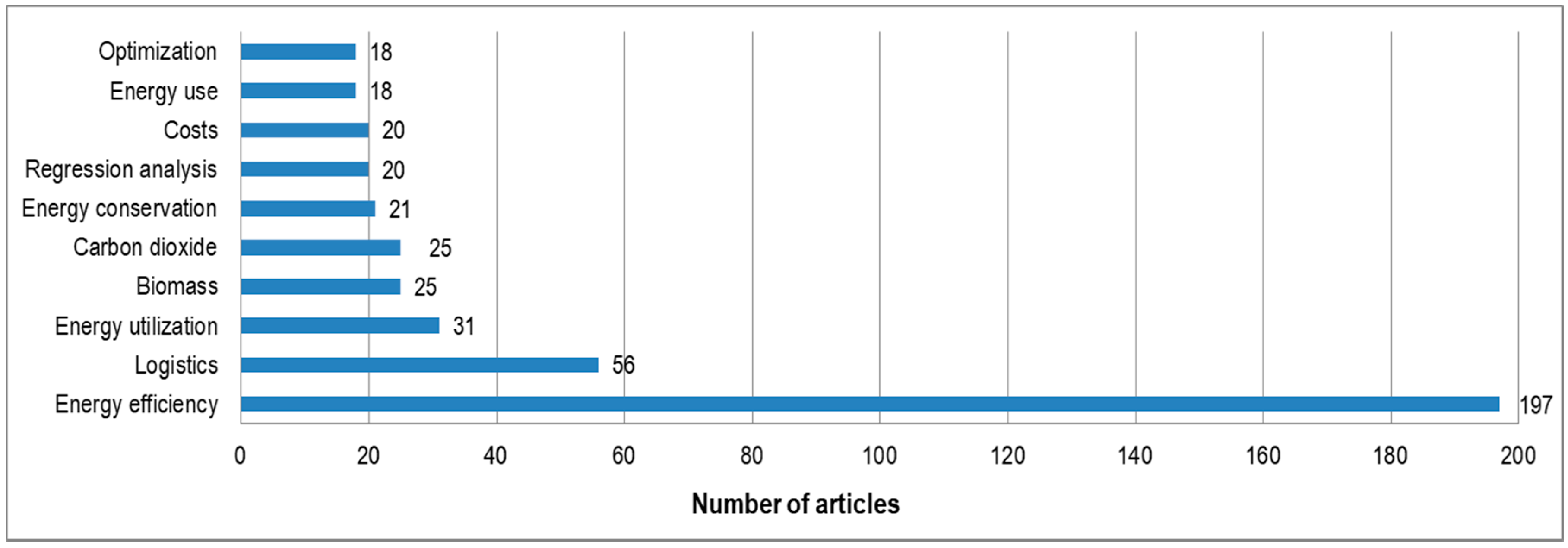

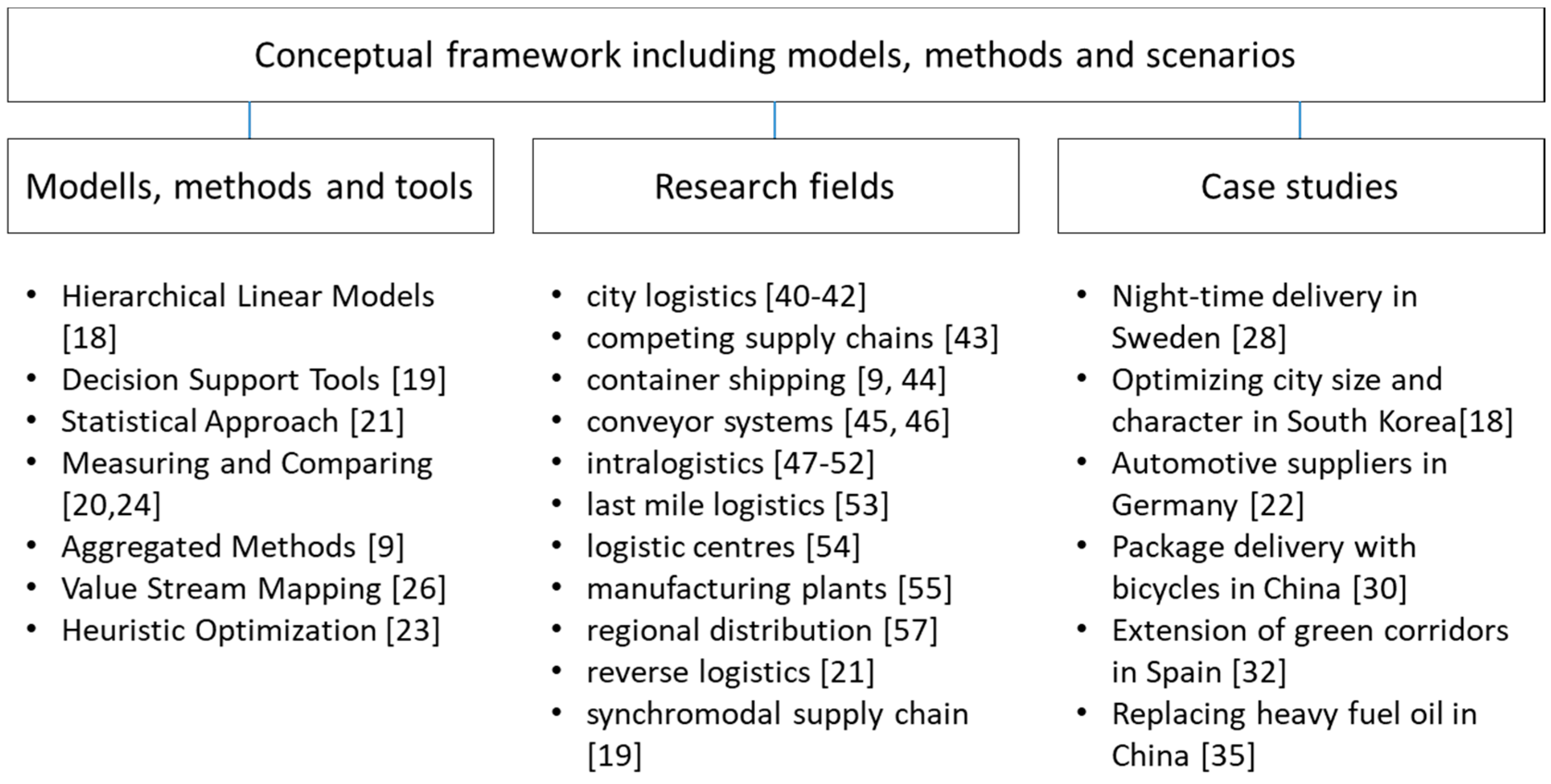
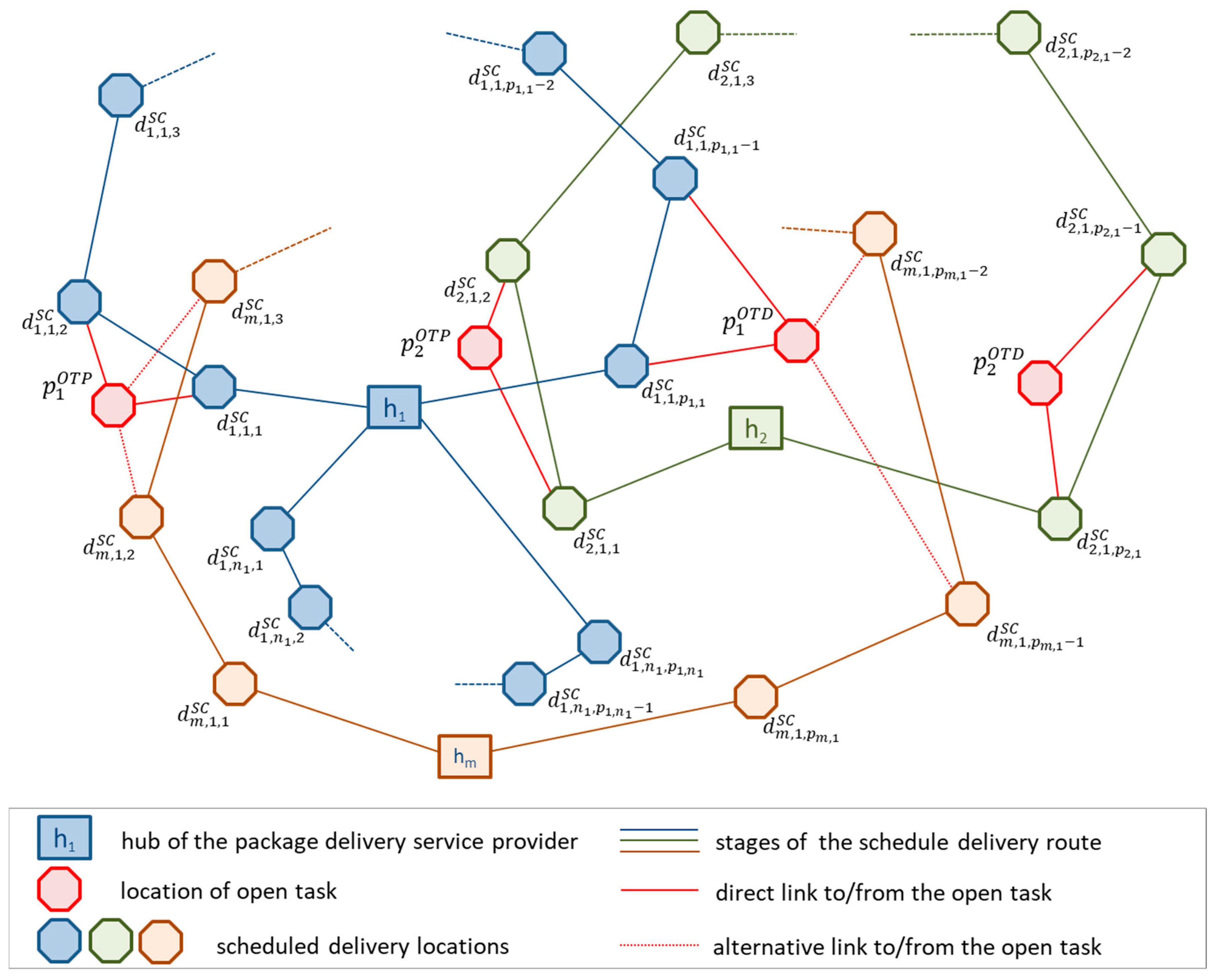

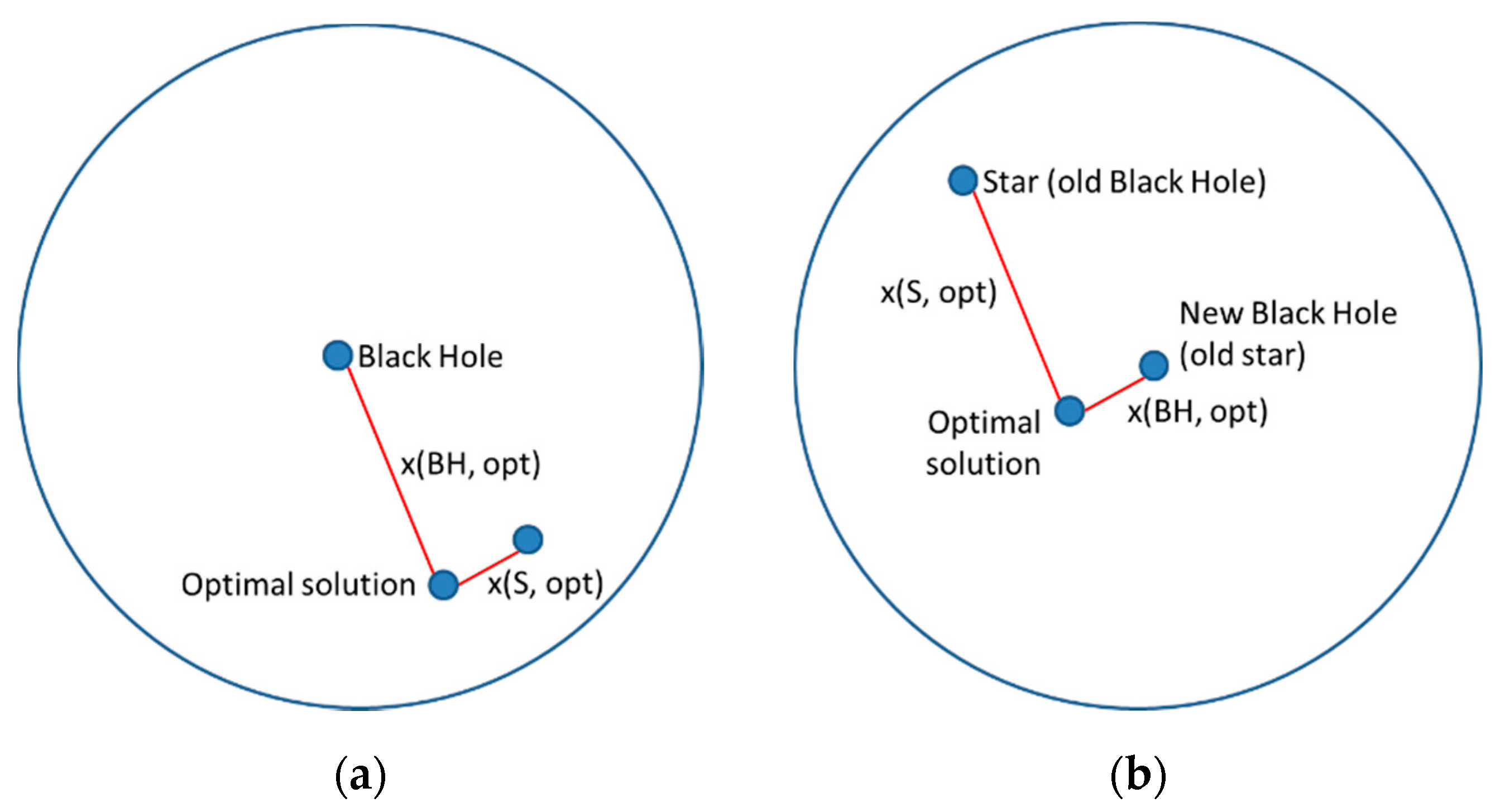


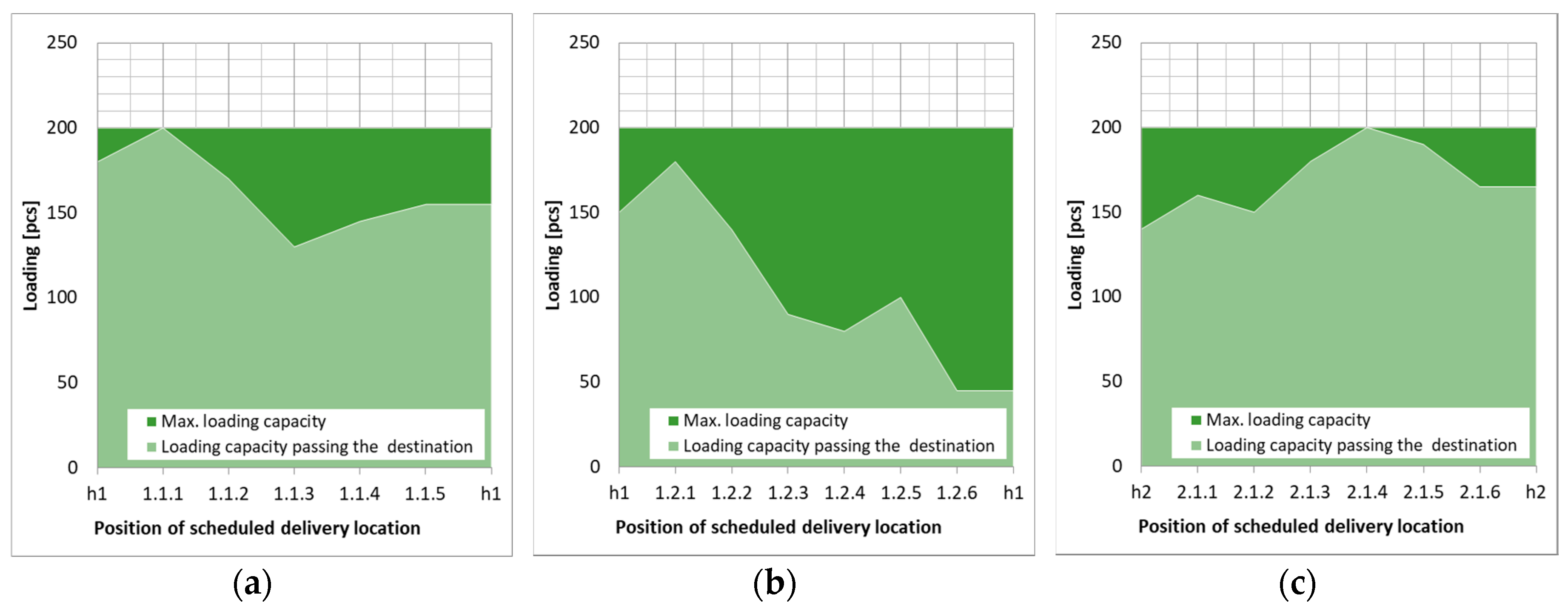
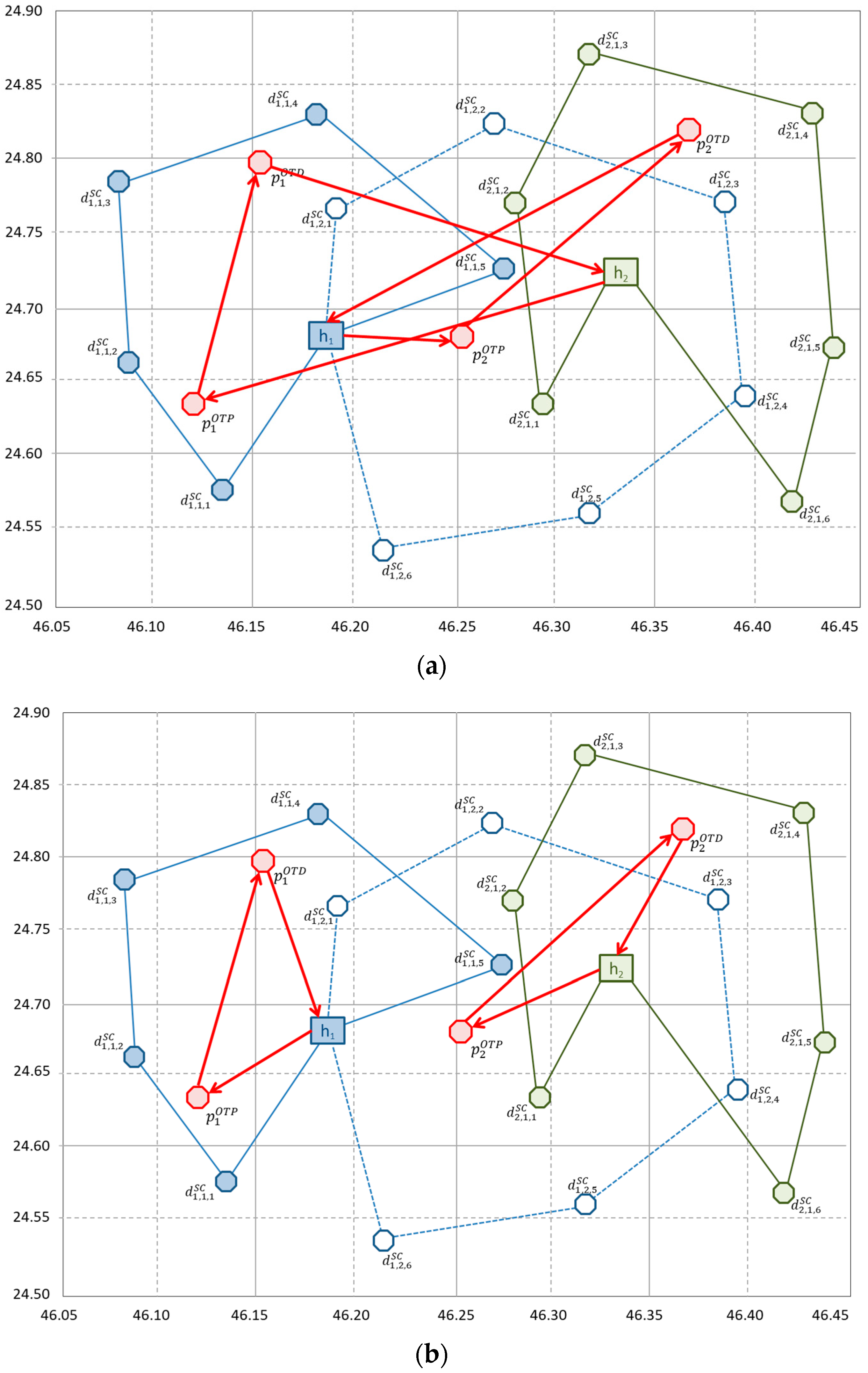

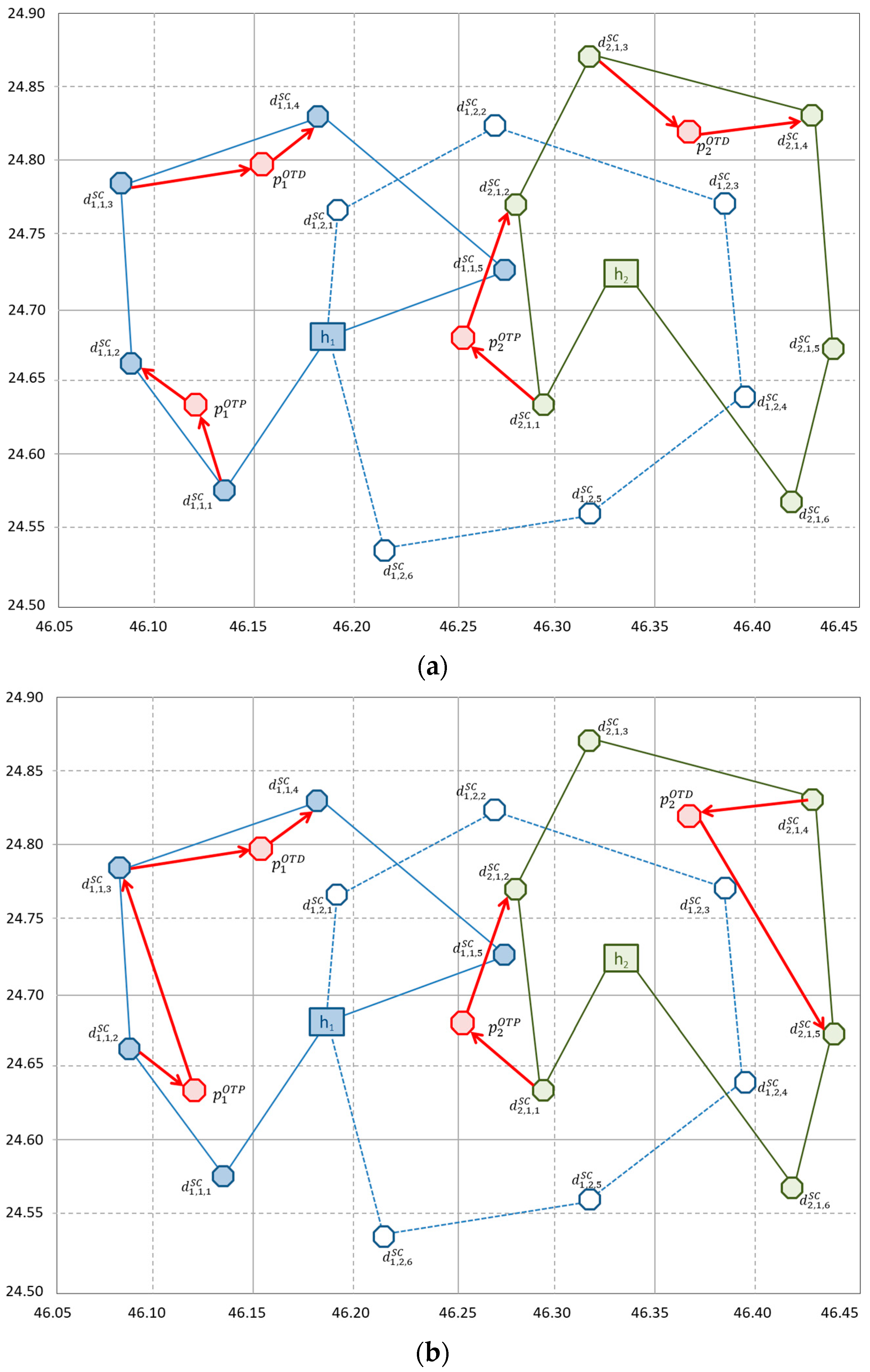
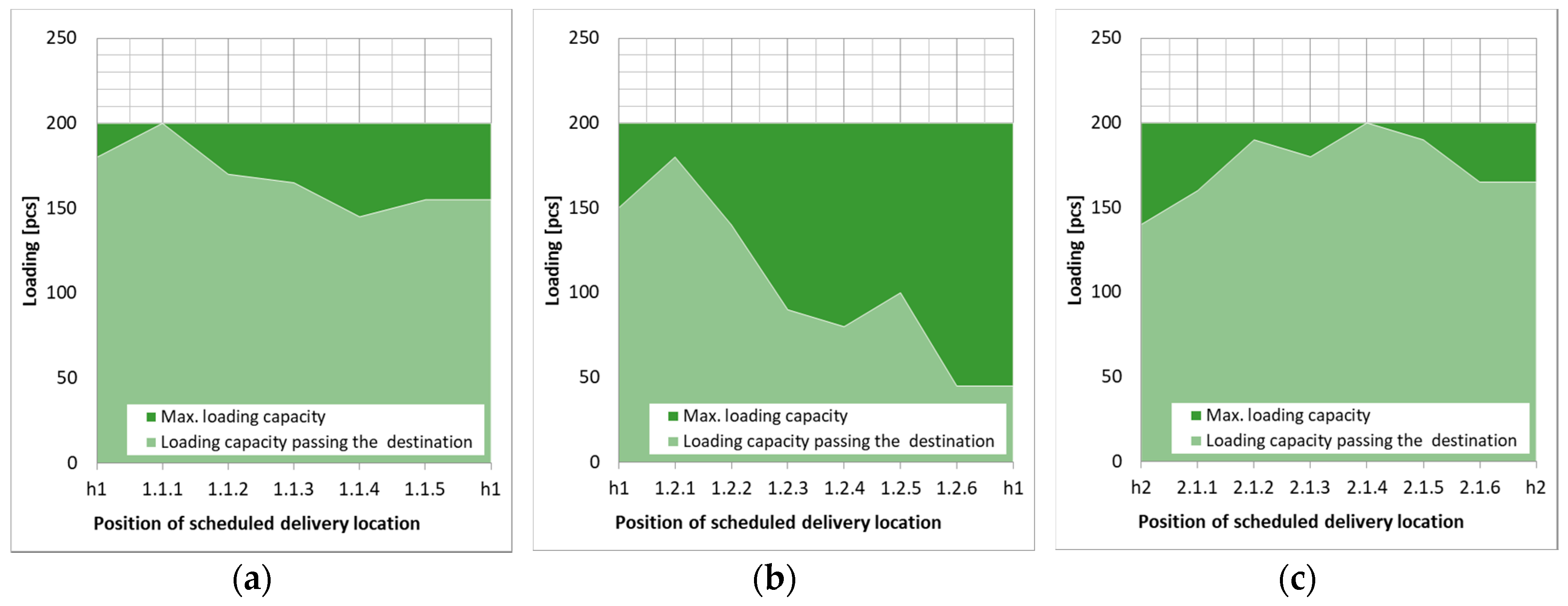

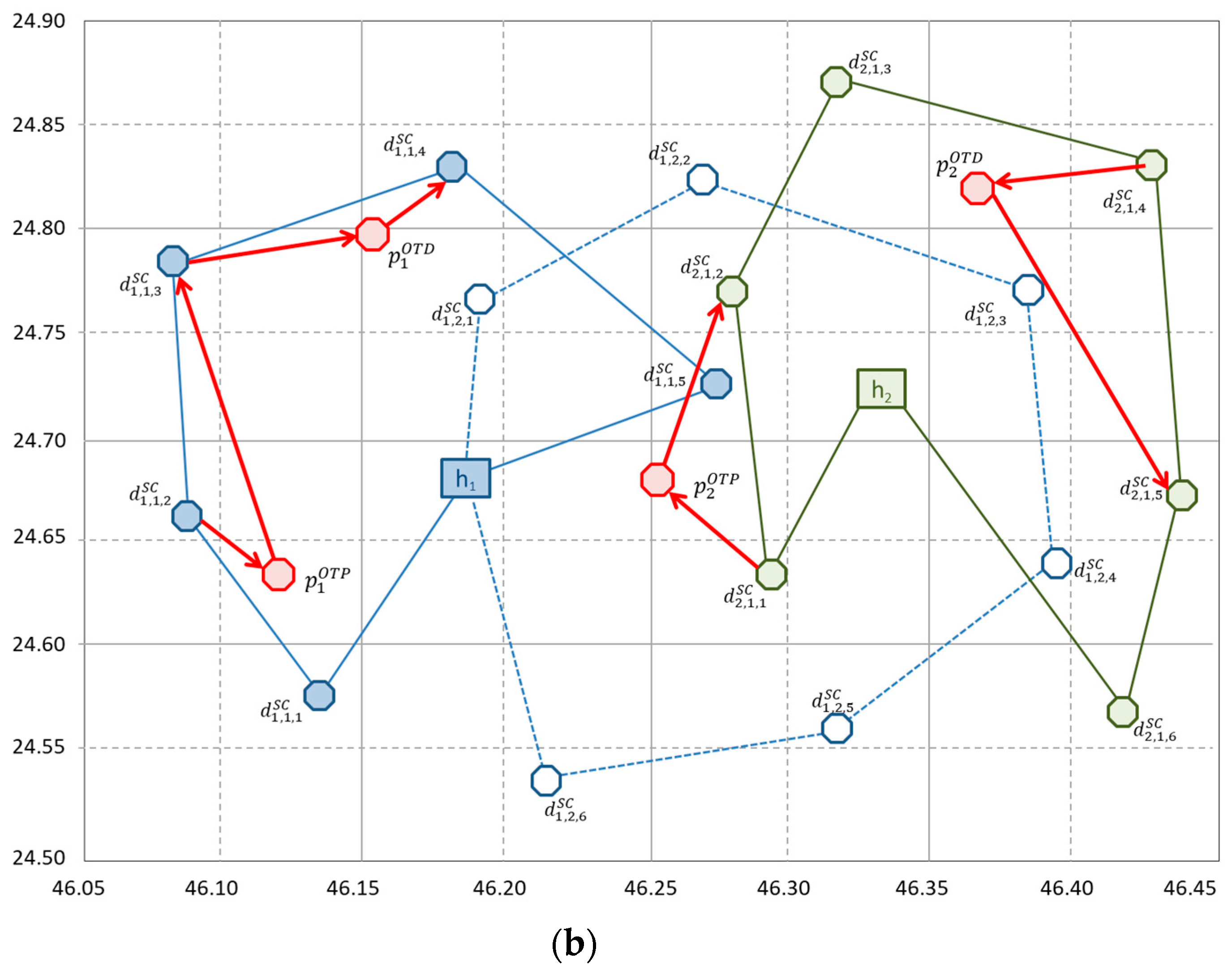

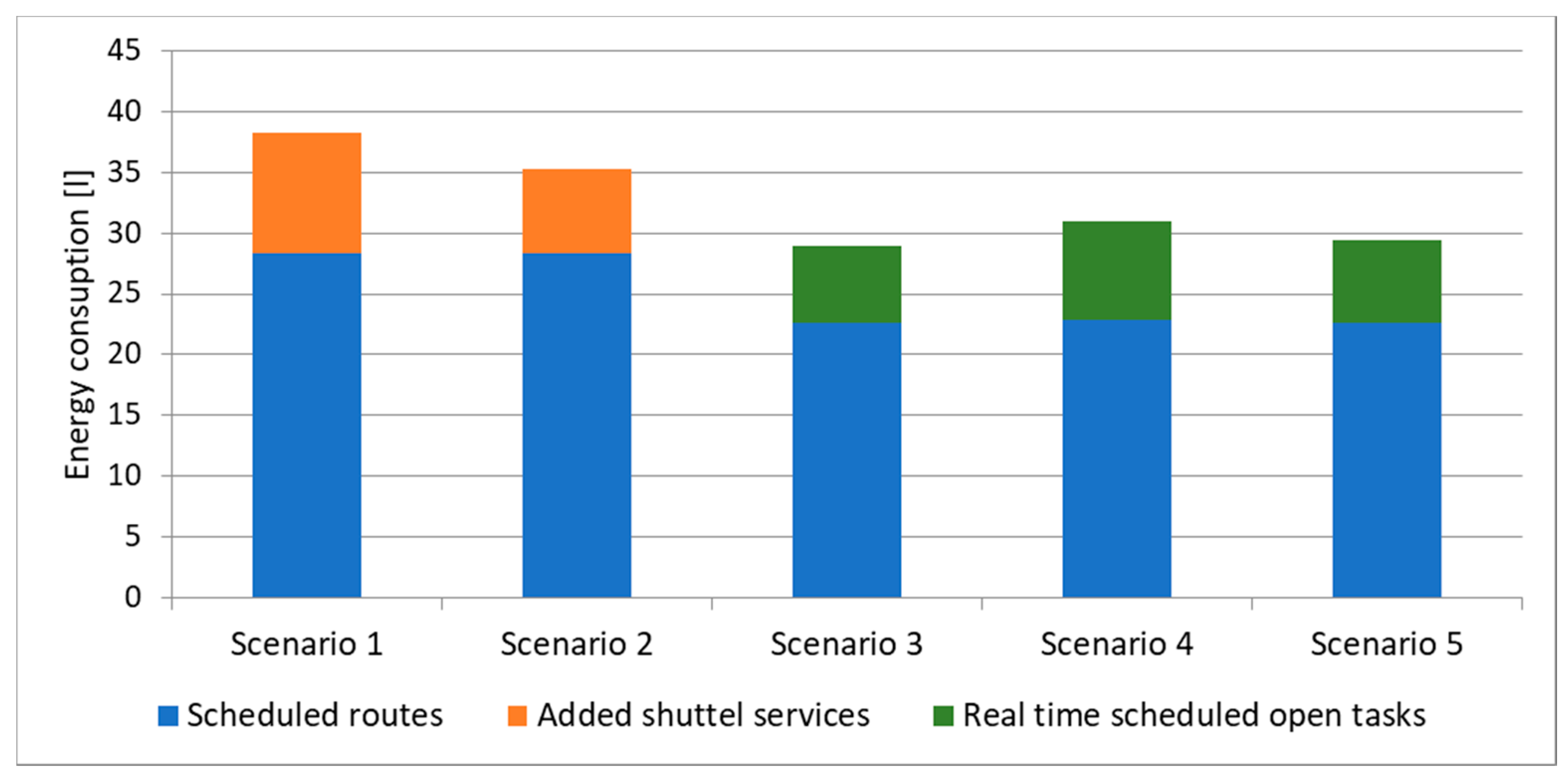
| Measure Type | Unit |
|---|---|
| Positions of hubs, delivery points, and open tasks | GPS coordinates |
| Energy usage of package delivery trucks | litre/delivery of all packages |
| Specific energy usage of package delivery trucks | litre/100 km |
| Loading capacity of package delivery trucks | pcs of standard postal boxes |
| Lengths of delivery routes | km |
| Assignment matrices | [0, 1] |
| Benchmarking Function | BHA | BHA/DSR 1 | BHA/HR 2 | BHA/LS 3 |
| 4.24 × 10−04 | 1.48 × 10−05 | 6.80 × 10−04 | 7.06 × 10−04 | |
| 3.24 × 10−02 | 3.24 × 10−02 | 3.24 × 10−02 | 3.24 × 10−03 | |
| 3.56 × 10−09 | 3.56 × 10−03 | 3.56 × 10−03 | 3.56 × 10−04 | |
| 8.96 × 10−09 | 7.01 × 10−09 | 1.41 × 10−07 | 4.61 × 10−09 | |
| Benchmarking Function | DSR/HR | DSR/LS | LS/HR | DSR/LS/HR |
| 3.59 × 10−05 | 2.54 × 10−04 | 2.54 × 10−04 | 3.70 × 10−05 | |
| 3.24 × 10−02 | 3.24 × 10−02 | 3.24 × 10−02 | 3.24 × 10−02 | |
| 3.56 × 10−03 | 3.56 × 10−03 | 3.56 × 10−03 | 3.56 × 10−04 | |
| 4.45 × 10−09 | 8.18 × 10−09 | 1.55 × 10−08 | 5.52 × 10−10 |
| PDSP 1/Route/Destination | Scheduled Delivery | Lower Limit of Delivery Time | Upper Limit of Delivery Time | Loading 2 |
|---|---|---|---|---|
| 1.1.1 | 10:00 | 9:00 | 10:10 | 20 |
| 1.1.2 | 11:00 | 11:00 | 11:05 | −30 |
| 1.1.3 | 12:00 | 11:00 | 12:45 | −40 |
| 1.1.4 | 12:30 | 12:00 | 14:00 | 15 |
| 1.1.5 | 14:00 | 12:00 | 16:00 | 10 |
| 1.2.1 | 10:20 | 9:00 | 10:30 | 30 |
| 1.2.2 | 10:45 | 10:00 | 12:00 | −40 |
| 1.2.3 | 11:50 | 11:00 | 13:00 | −50 |
| 1.2.4 | 12:30 | 12:00 | 14:00 | −10 |
| 1.2.5 | 13:30 | 12:00 | 16:00 | 20 |
| 1.2.6 | 14:00 | 12:00 | 14:00 | −55 |
| 2.1.1 | 10:20 | 9:00 | 11:00 | 20 |
| 2.1.2 | 10:45 | 10:00 | 11:40 | −10 |
| 2.1.3 | 11:50 | 11:00 | 12:55 | 30 |
| 2.1.4 | 12:10 | 12:00 | 14:00 | 20 |
| 2.1.5 | 12:40 | 12:00 | 16:00 | −10 |
| 2.1.6 | 13:15 | 12:00 | 15:30 | −25 |
| Open Task | PDSP Receiving the Open Task Assignment | Loading | Pickup Time | Delivery Time | ||
|---|---|---|---|---|---|---|
| Lower Limit | Upper Limit | Lower Limit | Upper Limit | |||
| 1 | 2 | 35 | 10:00 | 12:00 | 12:00 | 14:00 |
| 2 | 1 | 40 | 9:00 | 11:00 | 13:00 | 14:15 |
© 2018 by the author. Licensee MDPI, Basel, Switzerland. This article is an open access article distributed under the terms and conditions of the Creative Commons Attribution (CC BY) license (http://creativecommons.org/licenses/by/4.0/).
Share and Cite
Bányai, T. Real-Time Decision Making in First Mile and Last Mile Logistics: How Smart Scheduling Affects Energy Efficiency of Hyperconnected Supply Chain Solutions. Energies 2018, 11, 1833. https://doi.org/10.3390/en11071833
Bányai T. Real-Time Decision Making in First Mile and Last Mile Logistics: How Smart Scheduling Affects Energy Efficiency of Hyperconnected Supply Chain Solutions. Energies. 2018; 11(7):1833. https://doi.org/10.3390/en11071833
Chicago/Turabian StyleBányai, Tamás. 2018. "Real-Time Decision Making in First Mile and Last Mile Logistics: How Smart Scheduling Affects Energy Efficiency of Hyperconnected Supply Chain Solutions" Energies 11, no. 7: 1833. https://doi.org/10.3390/en11071833





